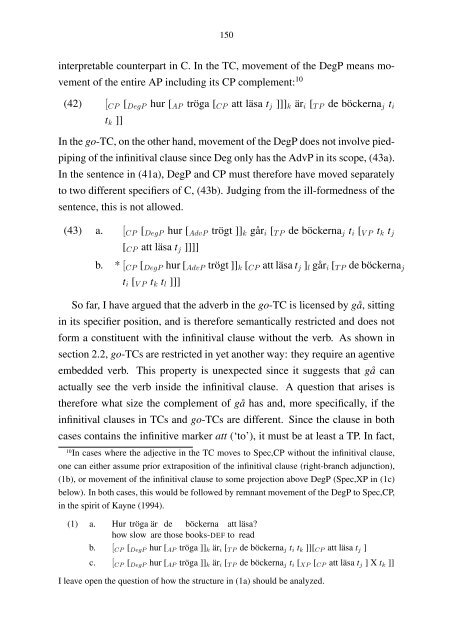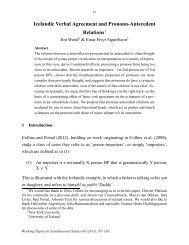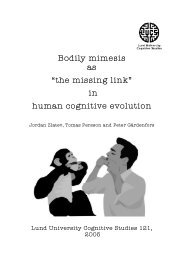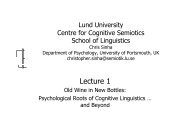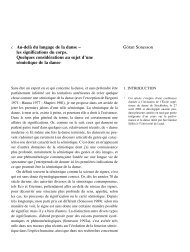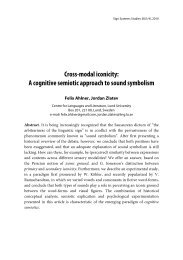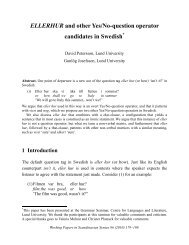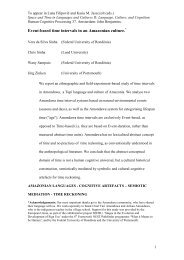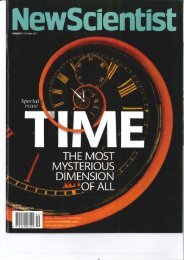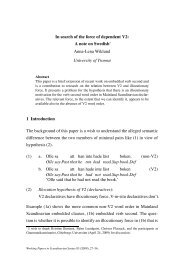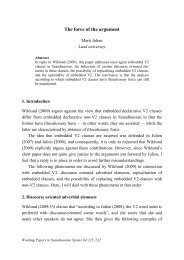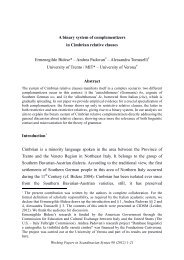Eva Klingvall On non-copula Tough Constructions in Swedish (PDF ...
Eva Klingvall On non-copula Tough Constructions in Swedish (PDF ...
Eva Klingvall On non-copula Tough Constructions in Swedish (PDF ...
Create successful ePaper yourself
Turn your PDF publications into a flip-book with our unique Google optimized e-Paper software.
150<strong>in</strong>terpretable counterpart <strong>in</strong> C. In the TC, movement of the DegP means movementof the entire AP <strong>in</strong>clud<strong>in</strong>g its CP complement: 10(42) [ CP [ DegP hur [ AP tröga [ CP att läsa t j ]]] k är i [ T P de böckerna j t it k ]]In the go-TC, on the other hand, movement of the DegP does not <strong>in</strong>volve piedpip<strong>in</strong>gof the <strong>in</strong>f<strong>in</strong>itival clause s<strong>in</strong>ce Deg only has the AdvP <strong>in</strong> its scope, (43a).In the sentence <strong>in</strong> (41a), DegP and CP must therefore have moved separatelyto two different specifiers of C, (43b). Judg<strong>in</strong>g from the ill-formedness of thesentence, this is not allowed.(43) a. [ CP [ DegP hur [ AdvP trögt ]] k går i [ T P de böckerna j t i [ V P t k t j[ CP att läsa t j ]]]]b. * [ CP [ DegP hur [ AdvP trögt ]] k [ CP att läsa t j ] l går i [ T P de böckerna jt i [ V P t k t l ]]]So far, I have argued that the adverb <strong>in</strong> the go-TC is licensed by gå, sitt<strong>in</strong>g<strong>in</strong> its specifier position, and is therefore semantically restricted and does notform a constituent with the <strong>in</strong>f<strong>in</strong>itival clause without the verb. As shown <strong>in</strong>section 2.2, go-TCs are restricted <strong>in</strong> yet another way: they require an agentiveembedded verb. This property is unexpected s<strong>in</strong>ce it suggests that gå canactually see the verb <strong>in</strong>side the <strong>in</strong>f<strong>in</strong>itival clause. A question that arises istherefore what size the complement of gå has and, more specifically, if the<strong>in</strong>f<strong>in</strong>itival clauses <strong>in</strong> TCs and go-TCs are different. S<strong>in</strong>ce the clause <strong>in</strong> bothcases conta<strong>in</strong>s the <strong>in</strong>f<strong>in</strong>itive marker att (‘to’), it must be at least a TP. In fact,10In cases where the adjective <strong>in</strong> the TC moves to Spec,CP without the <strong>in</strong>f<strong>in</strong>itival clause,one can either assume prior extraposition of the <strong>in</strong>f<strong>in</strong>itival clause (right-branch adjunction),(1b), or movement of the <strong>in</strong>f<strong>in</strong>itival clause to some projection above DegP (Spec,XP <strong>in</strong> (1c)below). In both cases, this would be followed by remnant movement of the DegP to Spec,CP,<strong>in</strong> the spirit of Kayne (1994).(1) a. Hur tröga är de böckerna att läsa?how slow are those books-DEF to readb. [ CP [ DegP hur [ AP tröga ]] k är i [ T P de böckerna j t i t k ]][ CP att läsa t j ]c. [ CP [ DegP hur [ AP tröga ]] k är i [ T P de böckerna j t i [ XP [ CP att läsa t j ] X t k ]]I leave open the question of how the structure <strong>in</strong> (1a) should be analyzed.


